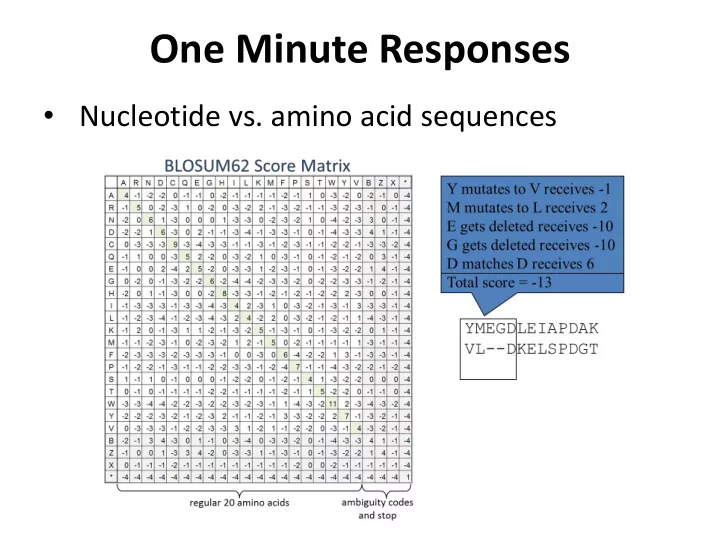

One Minute Responses • Nucleotide vs. amino acid sequences
Parsimony Genome 559: Introduction to Statistical and Computational Genomics Elhanan Borenstein
A quick review Trees: Represent sequence relationships A phylogenetic tree has a topology and branch lengths (distances) The number of tree topologies grows very fast with the number of species! Distance trees Compute pairwise corrected distances Build tree by sequential clustering algorithm ( UPGMA or Neighbor-Joining ). These algorithms don't consider all tree topologies, so they are very fast, even for large trees.
“Maximum Parsimony Algorithm” A fundamentally different method: Instead of reconstructing a tree, we will search for the best tree.
“ Pluralitas non est ponenda sine necessitate”
(Maximum) Parsimony Principle “ Pluralitas non est ponenda sine necessitate” (plurality should not be posited without necessity) William of Ockham Occam’s Razor: Of two equivalent theories or explanations, all other things being equal, the simpler one is to be preferred. William of Ockham (c. 1288 – c. 1348) "when you hear hoof beats, think horses, not zebras“ Medical diagnosis The KISS principle: "Keep It Simple, Stupid!" Kelly Johnson, Engineer “Make everything as simple as possible, but not simpler” Albert Einstein
Parsimony principle for phylogenetic trees Find the tree that requires the fewest evolutionary changes!
Lizard Island
Consider 4 species
Consider 4 species positions in alignment Sequence data: (usually called " sites“) The same approach would work for any discrete property that can be associated with the various species: Gene content (presence/absence of each gene) Morphological features (e.g., “has wings”, purple or white flowers) Numerical features (e.g., number of bristles)
Consider 4 species positions in alignment Sequence data: (usually called " sites“) Parsimony Algorithm 1) Construct all possible trees 2) For each site in the alignment and for each tree count the minimal number of changes required 3) Add all sites up to obtain the total number of changes for each tree 4) Pick the tree with the lowest score
Consider 4 species Sequence data: H closest All possible to C unrooted trees: or H closest or to G H closest to O
Consider 4 species Sequence data: For each site and for each tree H closest All possible count the minimal number of to C unrooted trees: changes required: or H closest or to G H closest to O
Consider site 1 What is the minimal number of evolutionary changes c that can account for the observed pattern? a a (Note: This is the “small parsimony” problem) c c c
Consider site 1 What is the minimal number of evolutionary changes c that can account for the observed pattern? a a (Note: This is the “small parsimony” problem) c c c
Consider site 1 c a a c c c
Consider site 1 c a a c c c
Consider site 1 c a a c c c
Consider site 2 Uninformative (no changes)
Consider site 3
Put sites 1 and 3 together
Now put all of them together Which tree is the most parsimony score parsimonious? 7 9 8
The parsimony algorithm 1) Construct all possible trees 2) For each site in the alignment and for each tree count the minimal number of changes required 3) Add all sites up to obtain the total number of changes for each tree 4) Pick the tree with the lowest score
The parsimony algorithm Too many! 1) Construct all possible trees 2) For each site in the alignment and for each tree count the minimal number of changes required 3) Add all sites up to obtain the total number of changes for each tree 4) Pick the tree with the lowest score
The parsimony algorithm Too many! 1) Construct all possible trees 2) For each site in the alignment and for each tree count the minimal number of changes required How? 3) Add all sites up to obtain the total number of changes for each tree 4) Pick the tree with the lowest score
The parsimony algorithm Too many! 1) Construct all possible trees Search algorithm 2) For each site in the alignment and for each tree count the minimal number of changes required How? Fitch’s algorithm 3) Add all sites up to obtain the total number of changes for each tree 4) Pick the tree with the lowest score
Recommend
More recommend